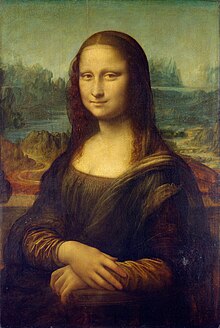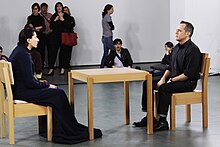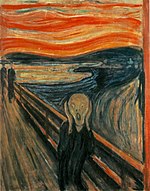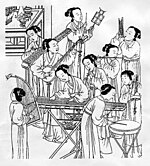Visual arts
The visual arts encompass the traditional plastic arts, as well as expressions that incorporate new art-oriented technology or unconventional elements, and that its greatest expressive component is visual, such as photography, videography, cinematography, and so-called new media art, including:
- digital art
- fanart
- photography
- net.art
- video
As well as other expressions appearing in the art of the 20th century, such as:
- environmental art
- kinetic art
- ephemeral art
- postal art
- public art
- urban art
- installation
- intervention
- Land Art
Other artistic disciplines, such as performing arts, have dimensions shared with the visual arts, so these definitions are not strict and are considered, in the field of visual arts, expressions such as:
- Art of action
- Interactive art
- Calligraphy
- Fluxus
- Grafiti
Drawing
Drawing is a means of making an image, illustration, or graphic using any of a wide variety of tools and techniques available online and offline. Usually involves making marks on a surface by applying pressure from a tool, or by moving a tool across a surface using dry media such as graphite pencils, pen and ink, ink brushes, crayons, crayons, charcoals, pastels and markers. Digital tools, such as pens and light pencils, are also used to simulate the effects of these. The main techniques used in drawing are: line drawing, hatching, cross hatching, random hatching, shading, scribbling, stippling, and blending. An artist who excels at drawing is called a cartoonist or cartoonist.
Drawing and painting date back tens of thousands of years. Upper Paleolithic art includes figurative art beginning between about 40,000 and 35,000 years ago. Non-figurative cave paintings consisting of manual stencils and simple geometric shapes are even older. Paleolithic cave paintings of animals are found in areas such as Lascaux, France and Altamira, Spain in Europe, Maros, Sulawesi in Asia, and Gabarnmung, Australia.
In ancient Egypt, ink drawings on papyrus, often depicting people, were used as models for painting or sculpture. Designs on Greek vases, initially geometric, later evolved into the human form with black-figure pottery during the VII century a. C.
With paper becoming common in Europe in the 15th century, drawing was adopted by masters such as Sandro Botticelli, Raphael, Michelangelo and Leonardo da Vinci who sometimes treated drawing as an art in itself and not as a preparatory stage for painting or sculpture.
Painting
Painting taken literally is the practice of applying pigment suspended in a support (or medium) and a binding agent (a glue) to a surface (support) such as paper, canvas, or a wall. However, when used in an artistic sense it means the use of this activity in combination with drawing, composition, or other aesthetic considerations in order to manifest the expressive and conceptual intent of the practitioner. Painting is also used to express spiritual motives and ideas; the places of this type of painting range from works of art that represent mythological figures in ceramics to the Sistine Chapel, passing through the human body itself.
History
Origins and early history
Like drawing, painting has its documented origins in caves and on rock walls. The best examples, believed by some to be 32,000 years old, are found in the Chauvet and Lascaux caves in southern France. In shades of red, brown, yellow, and black, the paintings on the walls and ceilings depict bison, cattle, horses, and deer.
In ancient Egyptian tombs you can find paintings of human figures. In the great temple of Ramses II, Nefertari, his queen, is depicted being led by Isis.The Greeks contributed to the painting but much of her work has been lost. One of the best surviving representations are the Hellenistic Fayum mummy portraits. Another example is the mosaic of the Battle of Issus in Pompeii, which was probably based on a Greek painting. Greek and Roman art contributed to Byzantine art in the IV century BCE. C., which started a tradition in icon painting.
The Renaissance
Aside from the illuminated manuscripts produced by monks during the Middle Ages, the next significant contribution to European art was that of Italian Renaissance painters. From Giotto in the 13th century to Leonardo da Vinci and Raphael in the early XVI, this was the richest period of Italian art as chiaroscuro techniques were used to create the illusion of three-dimensional space.
Painters from northern Europe were also influenced by the Italian school. The Belgian Jan van Eyck, the Dutchman Pieter Bruegel the Elder and the German Hans Holbein the Younger are some of the most successful painters of the time. They used the technique of glazing with oil paints to achieve depth and luminosity.
Dutch Masters
The 17th century witnessed the appearance of the great Dutch masters, such as the multifaceted Rembrandt, especially remembered for his portraits and biblical scenes, and Vermeer, who specialized in interior scenes of Dutch life.
Baroque
The Baroque began after the Renaissance, from the late 16th century to the late XVII. Among the main artists of the Baroque are Caravaggio, who made great use of tenebrism. Peter Paul Rubens, a Flemish painter who studied in Italy, worked for local Antwerp churches and also painted a series for Marie de' Medici. Annibale Carracci took influences from the Sistine Chapel and created the genre of illusionistic ceiling painting. Much of the development that occurred in the Baroque was due to the Protestant Reformation and subsequent Counter-Reformation. Much of what defines the Baroque is dramatic lighting and visual effects in general.
Impressionism
Impressionism began in France in the 19th century with an informal association of artists that included Claude Monet, Pierre- Auguste Renoir and Paul Cézanne who brought a new style of free brushwork to painting, often choosing to paint realistic scenes of modern life outside rather than in the studio. This was achieved through a new expression of the aesthetic traits demonstrated by brushstrokes and the impression of reality. They achieved an intense vibrancy of color through the use of pure, unmixed colors and short brushstrokes. The movement influenced art as a dynamic, moving through time and adjusting to new techniques and perception of art. Attention to detail became less of a priority in the production, while a biased view of landscapes and nature was explored for the artists' eye.
Post-Impressionism
Towards the end of the 19th century, several young painters took Impressionism a step further, using geometric shapes and unfamiliar colours. natural to represent emotions, while looking for a deeper symbolism. Notable Paul Gauguin, greatly influenced by Asian, African and Japanese art, Vincent van Gogh, a Dutchman who moved to France, where he was inspired by the strong southern sunlight, and Toulouse-Lautrec, remembered for his vivid paintings of nightlife in the Parisian neighborhood of Montmartre.
Symbolism, Expressionism and Cubism
Edvard Munch, a Norwegian artist, developed his symbolist approach in the late 19th century, inspired by the French Impressionist Manet. The Scream (1893), his most famous work, is widely interpreted as representing the universal anxiety of modern man. Partly as a result of Munch's influence, the German Expressionist movement originated in Germany in the early 20th century, when artists like Ernst Kirschner and Erich Heckel began to distort reality for emotional effect.
In parallel, the style known as cubism developed in France, as artists focused on the volume and space of crisp structures within a composition. Pablo Picasso and Georges Braque were the main defenders of this movement. Objects are broken down, analyzed, and reassembled in an abstract way. In the 1920s, the style developed into Surrealism with Dali and Magritte.
Engraving
Printmaking is the creation, for artistic purposes, of an image on a matrix that is then transferred to a two-dimensional (flat) surface using ink (or another form of pigmentation). Except in the case of a monotype, the same matrix can be used to produce many copies of the print.
Historically, the main techniques (also called media) involved are woodcut, line etching, etching, lithography, and screen printing (screen printing, serigraphy), but there are many others, including modern digital techniques. Normally, printing is done on paper, but other supports range from cloth and vellum to more modern materials.
History of Europe
Prints in the Western tradition produced before about 1830 are known as old master prints. In Europe, beginning around the year 1400 AD. C. woodcut was used to make master prints on paper using printing techniques developed in the Byzantine and Islamic world. Michael Wolgemut improved German woodcut from about 1475, and Erhard Reuwich, a Dutchman, was the first to use crosshatching. At the turn of the century Albrecht Dürer took Western woodcut to a stage that has never been surpassed, increasing the status of the single-sheet woodcut.
Chinese origin and practice
In China, the art of printmaking developed about 1,100 years ago as illustrations next to text cut out of woodblocks for printing on paper. At first, the images were mainly religious, but in the Song Dynasty, artists began to cut out landscapes. During the Ming (1368-1644) and Qing (1616-1911) dynasties, the technique was perfected for both religious and artistic prints.
Development in Japan 1603-1867
Woodblock printing in Japan (Japanese: 木版画, moku hanga) is a technique best known for its use in the ukiyo-e genre of art; however, it was also used very widely for the printing of illustrated books at the same time. Woodblock printing had been used in China for centuries to print books, long before the advent of movable type, but it was only widely adopted in Japan during the Edo period (1603-1867). Although similar to Western woodblock printing in some ways, moku hanga differs greatly in that water-based inks are used (as opposed to Western woodblock printing, which uses oil-based inks), allowing for a wide range of colors. of bright colors, glazes and color transparency.
Perception
In the perception of the work, our vision has a tendency to group or separate elements according to shape, contrast, color, lighting, etc. The visual arts are based on this visual perception and the sensory reception that is made of the work. Different visual codes of proportion, balance, rhythm, texture and tonal values that are taken into account by the creators in their communication with the viewer. The visual system of human beings assimilates information by interpreting it through visual stimuli related to their prior knowledge and their emotional state. The reception or discrimination of these stimuli translates into the ability to interpret information through the effects of light. visible perceived.
Gestalt psychology is a theory of perception that emerged in Germany at the beginning of the XX century that alludes to these modes of perception of the shape of what we see and how it is decoded by our brain through the associations that occur at the time of perception. Its basic principles are:
By grouping
There are several ways of grouping:
- By proximity: you have the visual tendency to group the elements when they have closeness with each other.
- By similarity: grouping when the elements are known, similar or equal figures among themselves.
- By continuity: search for similarities through significant continuity, that is, we first observe the main elements followed by the least important ones.
By figure/background
The visual trend separates the elements from the background or vice versa; since sometimes the background is also perceived as a figure.
By contour
The contour separates and distinguishes the figure from the background and is represented by a continuous or discontinuous line or in the limit of two different colors, called a clipping line.
Due to pregnancy
Tendency to visually fill in those empty spaces to complete an object.
Applied arts
The applied arts base their definition on the utility of an object created for a certain purpose. They can be considered within the plastic and visual arts when their artistic and aesthetic value transcends utility, it is also called utilitarian or functional art. When the decorative component is greater than the functional one, but maintains the reference, they are also considered within the decorative arts. Among them are a great variety of artisan forms such as:
- pottery
- orphanage
- wood carving
- upholstery
- glass
The new design-based utilities share space with the Applied Arts and are also considered in the field of Visual Arts for their use of visual language and aesthetic appreciation. Between them:
- interior design
- graphic design
- industrial design
References
- ↑ «drawing Δ Principles, techniques and history». Encyclopedia Britannica (in English). Consultation on 12 August 2020.
- ↑ Drawing history. Drawing drawings to paint]. Retrieved on 23 October 2009.
- ↑ "Draft." History.com. 2006. Archived from the original on 14 March 2009. Consultation on 23 October 2009.
- ↑ "pinture Δ History, elements, techniques, types and facts". Encyclopedia Britannica (in English). Consultation on 12 August 2020.
- ↑ History of Painting. World of History. Retrieved on 23 October 2009.
- ↑ «History of the art IVA visual arts». Encyclopedia Britannica (in English). Consultation on 12 August 2020.
- ↑ History of Renaissance painting. From the painting ART 340. Retrieved 24 October 2009.
- ↑ Mutsaers, Inge. «Ashgate Joins Routledge - Routledge». Ashgate.com. Consultation on 15 October 2018.
- ↑ «Art and Impressionist paintings, What is Impressionist Art? Introduction to Impressionism». Consultation on September 24, 2018.
- ↑ Impressionism. Webmuseum, Paris. Retrieved 24 October 2009
- ↑ Post-Impressionism. Metropolitan Museum of Art. Retrieved on 25 October 2009.
- ↑ Modern Art Movements. Irish art encyclopedia. Retrieved on 25 October 2009.
- ↑ The Printed Image in the West: History and Techniques. The Metropolitan Museum of Art. Retrieved on 25 October 2009.
- ↑ in Chinese Art. From the review of the engraving]. Retrieved on 23 October 2009.
- ↑ The history of engraving in China. From ChinaVista. Retrieved on 25 October 2009.
- ↑ American Evangelical Institute, Argentina. «Reads de la Gestalt». Archived from the original on 21 October 2012.
External links
Contenido relacionado
Nicolas Lancret
Alberto Giacometti
Benaki Museum















